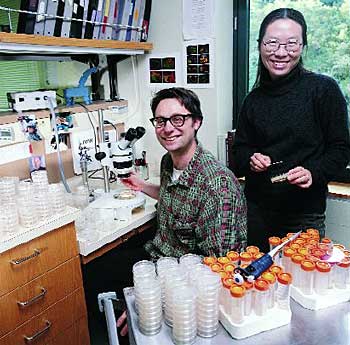understanding the foundations of lifeBiotechnology"We know from comparing the gene sequences of organisms ranging from yeast to humans that genes with fundamental roles have stayed much the same throughout evolution."–Manuel AresMolecular biologists Andrew Chisholm and Yishi Jin (Photo: R. R. Jones)  Having the complete code for the human genome will make it much easier for medical researchers to identify genes that cause or contribute to diseases. But having a gene's DNA code and understanding how it works are two entirely different matters. Surprisingly, one of the most productive approaches to understanding human genes involves fundamental research on simpler organisms such as baker's yeast, fruit flies, a tiny roundworm, and mice. At UCSC, molecular biologists studying these organisms are helping lay the groundwork for the medical advances promised by the Human Genome Project. "We know from comparing the gene sequences of organisms ranging from yeast to humans that genes with fundamental roles have stayed much the same throughout evolution," says professor of biology Manuel Ares. "As a result, what we learn about gene functions from studying model systems is likely to be relevant to humans." One popular model system is the roundworm Caenorhabditis elegans. An almost-microscopic, soil-dwelling nematode worm, C. elegans feeds on bacteria and lives in most temperate regions of the world. Molecular biologists tend to call it simply "the worm." As a system for studying the genetics of animal development, the worm offers many superlative features. It is the first multicellular animal for which the complete genome has been sequenced. The developmental steps leading from a single embryonic worm cell to the 959 cells that make up an adult worm have been traced and described cell by cell. And bio-technology enables researchers to manipulate the worm's genes in ways that shed light on the functions of specific genes. Assistant professor of biology Andrew Chisholm uses the worm to study the molecular signals that pass between cells in a developing animal. These signals orchestrate an orderly pattern of development. Chisholm's colleague, assistant professor of biology Yishi Jin, focuses on the development of the worm's nervous system, which consists of about 300 interconnected nerve cells. The human brain, in contrast, contains at least one trillion nerve cells. "We know a lot from studying the human brain directly, but we don't know how its structure develops and how all the neural connections are made," Jin says. Jin has been identifying genes involved in creating the worm's relatively simple neural circuitry, and so far all of the genes she has found in the worm have turned out to have matching genes in humans, as well as in other organisms such as mice and the fruit fly Drosophila. "The real power of the worm is that you can do a genetic analysis--for example, you can knock out a gene to find out what its biological function is--and then you can take that knowledge back into human systems where you wouldn't be able to do that kind of experiment," Chisholm says. UCSC biologists are also studying the genes that regulate development in Drosophila and mice. Assistant professor of biology Lindsay Hinck, for example, is studying the molecular signals that guide the growth of neurons and the formation of neural connections in the mouse brain. As for how all this fundamental genetic research will ultimately be applied in medicine, Chisholm noted that it is already having a major impact in the area of drug development. "Pharmaceutical companies are hiring researchers to study gene function in model organisms, because it allows them to identify a potential drug target in a simple system before they decide to spend millions of dollars developing a drug for humans," Chisholm says. According to Ares, another likely application of biotechnology in medicine is pharmacogenomics: using genetics to assess how a patient will respond to potential drug treatments. Although more than 99 percent of human DNA sequences are the same throughout the population, there are significant differences between individuals. Some of those differences affect how people metabolize drugs. "People vary in how they respond to a particular drug and whether they experience side effects," Ares says. "Using genetic profiling, doctors will be able to prescribe individually tailored drug treatments." But researchers must synthesize the information obtained from research on different organisms to make these applications a reality. "It will be eons before we have for humans the kind of detailed knowledge we have of the worm, but we should be able to take what we learn from the worm and apply it to humans," Ares says. --Tim Stephens |
Return to Winter 2000 Issue Contents | Millennium Feature